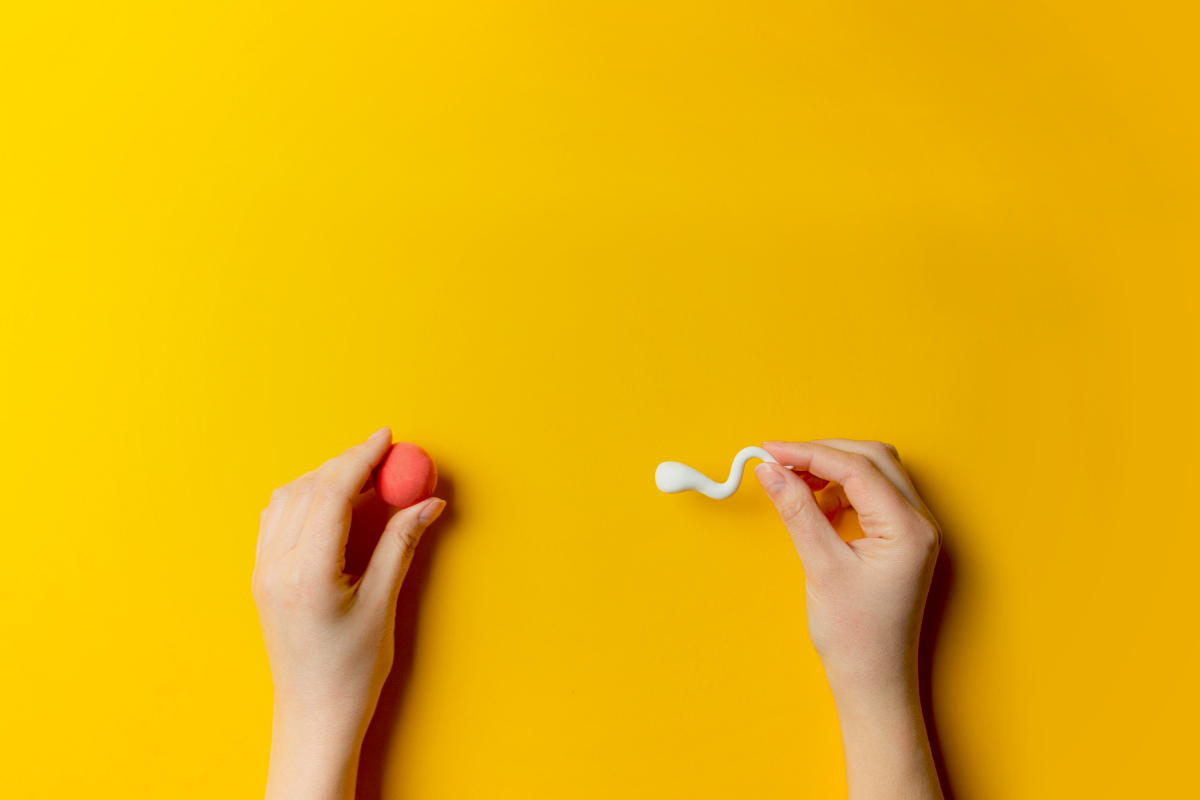Many of us, especially those of us who are not in a heterosexual relationship, assume that we need fertility clinics and high-tech interventions to make a pregnancy happen. In many cases, though, this is not necessary.
Depending on your fertility picture, where the sperm is coming from, and your personal preferences, doing at-home insemination could be the perfect place to start your trying-to-conceive journey.
Let’s dive into:
- What is at-home insemination?
- Who is it right for?
- How do you do an at-home insemination?
- What are the success rates?
As a reminder: there are several other steps to consider before an at-home insemination, including choosing your donor, getting a sense of your fertility picture, and setting up legal protections for your family. Please review that process carefully before considering this option.

What is at-home insemination?
At-home insemination is the process of putting a semen sample as close to the cervix as possible for the purpose of trying to conceive. It is done at home, rather than a clinic, and can be performed alone or by a partner or trusted friend. (You can watch a short video demo of how it works here.)
At-home insemination is similar to intracervical insemination (known as ICI), and sometimes the terms are used interchangeably. Technically, though, ICI refers to the process of putting semen into the cervix, whereas at-home insemination refers to putting semen inside the vagina. These shouldn’t be confused with intrauterine insemination (IUI), where a health-care provider puts a washed semen sample directly into the uterus.
When doing at-home insemination, it’s important to use unwashed semen samples. What does that mean?
First, a little bit about semen. Ejaculate, or seminal fluid, is a complex substance, containing sperm cells, mucus, proteins, and other secretions. All of these components have a function: to protect the sperm from the acidity of the vagina and offer the sperm cells nutrients for their journey toward the (hopefully) waiting egg.
Unwashed semen means that the seminal fluid hasn’t been processed — it’s just fresh or previously frozen ejaculate. Washed semen refers to the process of separating the sperm cells from the extra substances found in seminal fluid, in preparation for insemination directly into the uterus.
If you’re buying donor sperm from a bank, you will have the choice between ICI-ready (unwashed, frozen) and IUI-ready (washed, frozen) vials. If you’re planning to do at-home insemination, I strongly recommend getting the ICI-ready vials as unwashed sperm have the nutrients and protective qualities that help the semen swim through the cervix and the uterus. While this isn’t well-studied, unfortunately, I’ve seen much higher success rates with ICI-ready vials for at-home insemination. IUI-ready sperm works best for IUI.
Who is it right for?
At-home inseminations may be a great place to start if you are using a directed (identified) donor with fresh sperm or have unwashed sperm samples from a bank. In some cases, heterosexual couples who are looking for non-clinical fertility support or want a break from timed intercourse opt for at-home insemination as well.
People with a regular menstrual cycle and clear ovulation signs are the best candidates for at-home inseminations. If you are someone with irregular periods, a fertility-related diagnosis like PCOS, or other complex medical history that may affect your fertility, you will probably be best served at a fertility clinic.
If trying to conceive via at-home insemination with a known donor or a partner who has sperm, I always recommend doing a semen analysis to make sure the sperm count and motility is high enough to optimize at-home insemination success. You can get a semen analysis through your primary care physician, some local sperm banks, or a company that does it by mail.
If you’ve been trying to conceive via at-home insemination for three to six months without getting pregnant, I recommend consulting with a fertility doctor or trained midwife to consider exploring other paths.
How do you do an at-home insemination?
There are four main steps in an at-home insemination: setting up, preparing the sample, inserting the sample, and post-insemination. Let’s walk through them.
Setting up
For an at-home insemination, you’ll need an over-the-counter syringe or menstrual cup for the insertion process. Another option is a specialized product like Mosie Baby.
As for location, the insemination can be done on any comfortable surface. I recommend setting up your bed so that there is a pillow covered with a towel (to catch any errant fluids) under your hips.
Preparing the sample
This process varies depending on where your sperm is coming from.
For directed donors or partners, the person providing sperm ejaculates into a clean cup. Keep the semen at body temperature after ejaculation by holding the jar between your legs or under your arm. It’s recommended to inseminate within 45 minutes of ejaculation.
Some people have ideal directed donors who live multiple hours or states away. If this is your situation, instead of traveling to your donor or having them come to you every month, it may make sense to consider setting up a Directed Donor account at a sperm bank close to where your donor lives. This allows your donor to donate to a bank where they can process the sperm appropriately for whatever conception method you have planned, freeze it, and then ship it directly to your home in time for your ovulation window.
When using previously frozen unwashed sperm from a bank, you’ll organize ahead of time to have your sperm sample shipped to your home (most banks require physician authorization for this). To defrost your sperm sample, use protective oven mitts to remove it from the tank (it’s so cold it can burn you). Once you’ve removed the plastic vial, you can either:
- Place the vial on a counter for 10 to 15 minutes, until the sperm has liquefied
- Submerge it in a warm water bath that is 98.6℉ until it has liquefied
- Put it under your arm for about 5 minutes, until it has liquefied
All of these defrosting methods have been studied and work well; however, there is some research that suggests that sperm motility may be optimal when using the water bath method.
Inserting the sample
If using a syringe, draw up the seminal fluid and then, while lying down, insert the syringe as deep inside the vagina as feels comfortable. Once the syringe is placed, you or a partner can push down the plunger on the syringe to release the sample.
If using a menstrual cup, carefully put the sample inside the cup and place it inside your body. Some people find that squatting is the easiest position for insertion. Once it’s inside, lie down and elevate your hips for at least 20 minutes.
We don’t have data on what the most effective method is here, so do what feels best for you.
Post-insemination
There’s some research (albeit with a very small sample) that suggests that, when possible, having an orgasm post-insemination can help more sperm cells stay inside the uterus, since the uterine contractions caused by orgasm assist the sperm’s journey toward the (hopefully) waiting egg. These samples are small and the results are mixed, however, so if that feels hard to achieve, don’t stress about it.
Some people use cervical caps after at-home insemination to keep the semen as close to the cervix as possible for up to 12 hours after the insemination. Cervical caps are small, flexible silicone caps that go over the cervix and were originally invented as a form of birth control. There was a study published in 1986 that found that heterosexual couples who used cervical caps after intercourse got pregnant more quickly than the couples who didn’t. It’s unclear if it makes a significant difference, but it’s a low-cost, easy intervention that you may choose to try.
What are the success rates?
At-home insemination with fresh sperm has about the same success rates as heterosexual intercourse — about 15% to 20% per attempt for people with no fertility issues.
At-home insemination with previously frozen sperm doesn’t have as favorable rates of conception, because freezing and then thawing semen often negatively affects sperm quality. Rates of success with frozen sperm are about 5% to 10% per cycle.
I generally advise my clients using frozen sperm to consider IUI either at home with a midwife or at a fertility clinic, because rates of success with frozen sperm are so much higher with IUI than with ICI (and sperm is expensive!).
The bottom line
- At-home insemination is a great way to try to conceive when you have normal fertility signs and are using fresh sperm or previously frozen, unwashed sperm from a bank.
- The actual procedure is easy to do at home with over-the-counter products.
- The process varies depending on whether you use fresh or previously frozen sperm at home.
- Consider changing your method if you’ve tried at-home insemination for three to six cycles without getting pregnant.













Log in